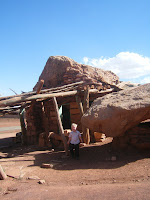Slow Death of the Pocketbook
It's a small trading post, established 1850, perched at the eastern edge of
 the Grand Canyon. Two Native Americans sit outside, drinking a soda, and watching the people walk by...into the much larger, modern day trading post next door. filled with several native crafts and tourist type knick knacks, with a deli in the back. There was a virtual geocache at the end of the parking lot, and after spending some time there, I spent an even greater time period shopping inside the doors. Pottery of every type imaginable, with many different textures and colors, lined the shelves, most with steep prices reflecting the degree of craftsmanship. Dream catchers, moccasins, beaded necklaces, furs, and coffee mugs with western designs grabbed the eye. Torquoise necklaces and totem animals gleamed from display counters. Showing economic restraint in the face of such temptation was very difficult. I finally fled the store after purchasing two small vases and a little souvenir for Kaleb (AJ had gotten one at the Grand Canyon store), considering myself very lucky not to have broken the bank in that place.
the Grand Canyon. Two Native Americans sit outside, drinking a soda, and watching the people walk by...into the much larger, modern day trading post next door. filled with several native crafts and tourist type knick knacks, with a deli in the back. There was a virtual geocache at the end of the parking lot, and after spending some time there, I spent an even greater time period shopping inside the doors. Pottery of every type imaginable, with many different textures and colors, lined the shelves, most with steep prices reflecting the degree of craftsmanship. Dream catchers, moccasins, beaded necklaces, furs, and coffee mugs with western designs grabbed the eye. Torquoise necklaces and totem animals gleamed from display counters. Showing economic restraint in the face of such temptation was very difficult. I finally fled the store after purchasing two small vases and a little souvenir for Kaleb (AJ had gotten one at the Grand Canyon store), considering myself very lucky not to have broken the bank in that place.Then, as we were making our way around the twists and turns of the Marble Canyon area, we saw many little stands, flea market syle, out along the high
 way, or down a dirt road off to an overlook. Many stood empty, but a fair enough were doing a bang up business out there, selling crafts off the side of the road.
way, or down a dirt road off to an overlook. Many stood empty, but a fair enough were doing a bang up business out there, selling crafts off the side of the road.We watched cliffs in the distance come closer, and followed the weave of the road as it struggled to stay next to the winding river. There was a man in an old RV we followed for some time before being able to pass him, with all the curves, and T got frustrated because of the view we could not fully see. We got in front of him just in time to get some nice views of the Vermillion Cliffs, which might have been my favorite spot along the drive.
As the road and river curved steeply to the west, we came upon two very interesting virtual waypoints, The Navajo Bridge and Cliffdwellers. The historic bridge was a sturdy steel bridge constructed in the late 1920s, and had a nice interpretative area and gift shop.
The Cliffdwellers was nothing formalized as that, but a trading post set up in the shade of one of the boulders that had shelters carved into them was doing a booming business, and got some more of my cash. I was hoping now just to get out of Utah so I could stop spending my money on Native American crafts. T kept teasing me about this, since I had been giving him
 such a hard time about pre-trip budgeting, and AJ kept pouting about things he wanted as well.
such a hard time about pre-trip budgeting, and AJ kept pouting about things he wanted as well.I thought initially that the Cliffdwellers abodes had been inhabited by Native Americans, but the sign nearby one of them told a different story, which I found most interesting. A woman traveling solo by automobile in 1928 had broke down at this location, and was so interested in the property that she bought it, and in the 1930s, invited friends to come live there and turn the boulders into dwellings. So it was a white girl thing after all, who knew? The automobiles at the time were manufactured with the gas tank in a location that would run empty if the cars made their way up the canyon road in the normal fashion, so travelers during that era had to drive their cars backwards up the incline to avoid running out of gas! Based on this information, I would say that woman traveling solo who bought the property sure had a lot of courage.
Both of these places had a great wind factor, and with the air being much drier than we were used to, we kind of wanted to stay inside the car for a while. After a much needed caffeine break, a driver switch, and a couple of pathetic attempts to get some more geocaches on this leg, we slowly made our way into St George, Utah, where we promply got lost.
Personally, I was very glad to make it out of Arizona without losing all my money to the Navajo, and to reach our destination, and a bed. Now, on to Utah's adventures...

VERMILLION CLIFFS


























No comments:
Post a Comment